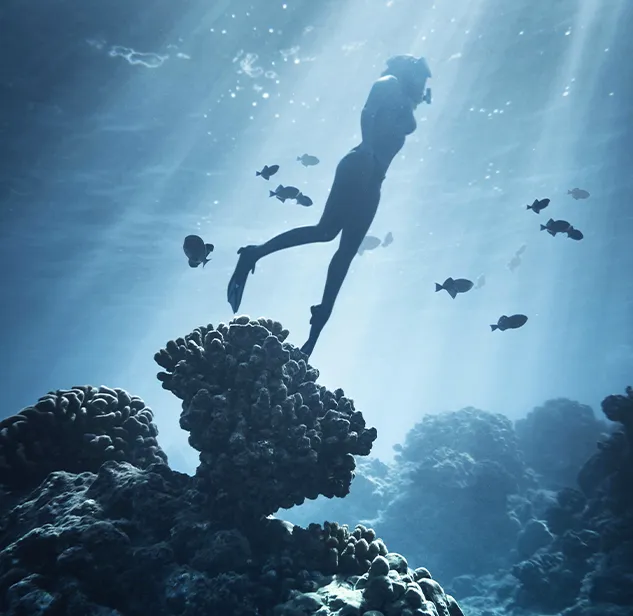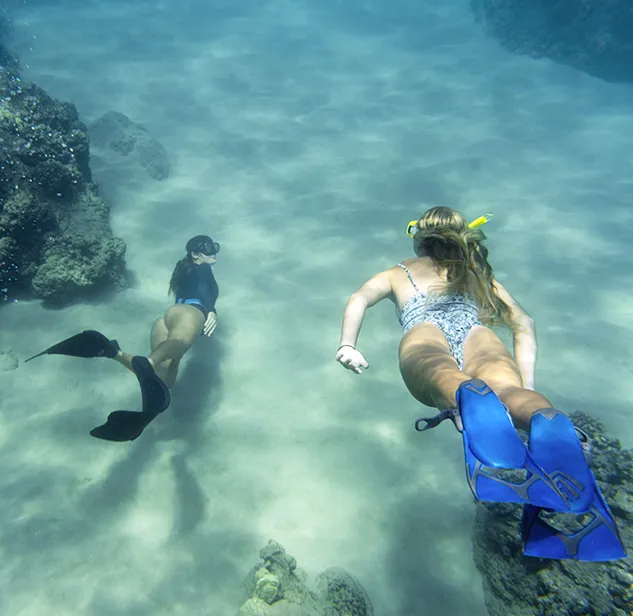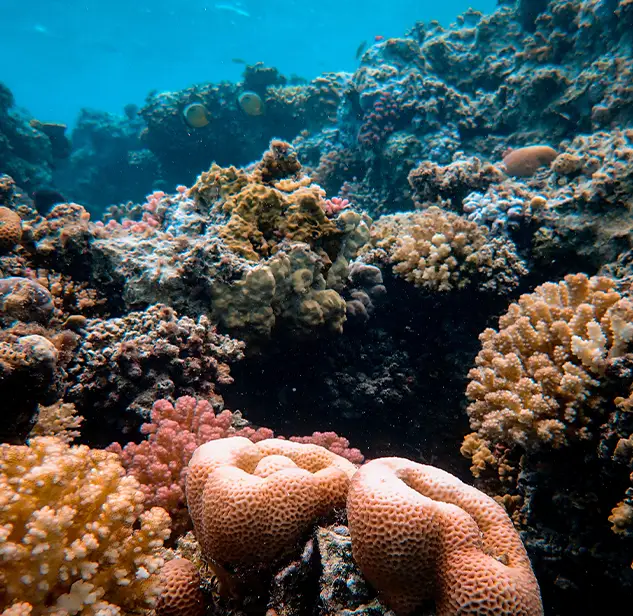The best spots for snorkeling and diving in Sardinia and Corsica
Crystal-clear waters and biodiversity
The crystal-clear waters separating Sardinia from Corsica hide a true paradise for snorkeling and diving enthusiasts. Between secluded coves, nature reserves, and seabeds rich in biodiversity, the entire area offers breathtaking experiences suitable for both beginners and more experienced divers. In this article, we take you on a journey to discover the best spots between the two islands, highlighting their main features, how to reach them, and what to expect from a naturalistic point of view. Put on your mask: let’s go!

Best snorkeling spots in Corsica
Cala di Fazzio, the “Little Caribbean” – Bonifacio
Located just a few kilometers from the port of Bonifacio, Cala di Fazzio is a cove sheltered by rocks, known for its white sand and transparent turquoise-reflecting waters, hence the nickname “Little Caribbean.” Ideal for family snorkeling, it can be reached with about a 20-minute walk from the Paragan parking lot.
The area hosts schools of castagnole (picarel), salpa (salema), and small wrasses. Sea urchins and small moray eels can also be spotted among the rocks.
Cala Achiarina, Cala della Chiesa, and Cala di u Grecu – Lavezzi Islands
The Lavezzi archipelago, south of Corsica, is a paradise for sea lovers. Its hidden coves — like Achiarina, della Chiesa, and u Grecu — offer shallow waters and extraordinary marine biodiversity.
Accessible only by boat (excursions depart daily from the port of Bonifacio), they are perfect for swimming among parrotfish, sea bream, white seabream, and abundant Posidonia oceanica vegetation, essential for the coastal ecosystem.
Palombaggia Beach – Porto-Vecchio
Located 10 km from Porto-Vecchio, Palombaggia is one of Corsica’s most famous beaches. Besides its clear waters, it offers rocky areas ideal for observing small schools of fish, starfish, and red algae formations. Accessible by car, it is also suitable for those looking for a comfortable, well-equipped spot.
Calanques de Piana – Gulf of Porto
Among the most striking natural wonders of western Corsica, the Calanques de Piana feature deep waters with intense blue reflections, red cliffs, and rocky seabeds rich in biodiversity. Easily reachable by car from Porto, the most beautiful section is explored by boat or kayak. The seabed hosts gorgonians, octopuses, groupers, and schools of small fish among the rock crevices.

Where to snorkel in Sardinia
Capo Testa and Cala Spinosa – Santa Teresa di Gallura
Capo Testa is a granite promontory with a wild charm. Cala Spinosa, one of its hidden gems, is reachable by trail and offers a snorkeling experience among rocky coves and emerald-colored water.
Among the rocks, castagnole, crabs, and occasionally small octopuses can be seen. The presence of submerged rock formations creates a fascinating environment.
Cala Brandinchi, the “Little Tahiti” – San Teodoro
One of Sardinia’s most photographed beaches, Brandinchi is near San Teodoro, about 25 km from Olbia. With white sand and shallow seabeds, it is ideal for family snorkeling.
On the sandy seabeds, flounders, small soles, and numerous limpets among the emerging rocks can be spotted. In the calmer areas, starfish and crabs are commonly seen.
Cala dei Francesi and Cala Moresca – Gulf of Aranci
Cala dei Francesi is a small cove hidden among the rocks, loved for its clear seabeds. It is reachable on foot via a coastal path near Gulf of Aranci. Here, schools of salpa, sea bream, and sometimes dolphins can be spotted.
Just a few steps away, Cala Moresca is equally charming: crystal-clear water and a rocky seabed provide refuge to many coastal species, including octopuses, sea urchins, and parrotfish.
Cala del Bollo and Cala d’Inferno – Porto Conte
In the Porto Conte Regional Natural Park, a few kilometers from Alghero, Cala del Bollo and Cala d’Inferno are two quiet spots accessible only on foot or by boat.
The seabeds feature rocky walls with sponges, red gorgonians, and schools of groupers. Nearby is the Nereo Cave, famous for diving, where lobsters, congers, and moray eels can be spotted.
Cala Goloritzé and Cala Mariolu – Gulf of Orosei
Two of the most iconic beaches on eastern Sardinia, accessible by trekking or boat from Cala Gonone or Santa Maria Navarrese.
Goloritzé offers seabeds with rocks and sand, populated by needlefish, limpets, and small schools of gilthead bream.
Mariolu is famous for its white pebbles and transparent water, where white seabream, castagnole, and deeper down, groupers can be found.

Marine flora and fauna sanctuaries in Sardinia
La Maddalena Archipelago National Park and Caprera Island
A true marine sanctuary in the north, with crystal-clear waters and pristine habitats. The seabeds around the islands of Spargi, Budelli, Razzoli, and Santa Maria are perfect for diving and snorkeling.
Accessible only by boat (with guided tours from Palau or La Maddalena), they offer encounters with dolphins, groupers, and schools of salpa. The Posidonia here is lush, creating ideal refuges for many species.
Caprera, connected by a bridge to La Maddalena, hosts protected coves like Cala Coticcio, also known as “Tahiti.” Its waters are so clear you can see anemones, sea urchins, and even seahorses in calm areas.
Villasimius – Capo Carbonara Marine Protected Area
Villasimius, on the southeastern coast of Sardinia, lies at the heart of a marine protected area. The beaches of Porto Giunco and Punta Molentis offer direct access to fauna-rich seabeds.
Frequent sightings of peacock wrasses, sea bream, and rays occur. Guided dives allow exploration of the Santa Caterina shoal and the wreck of the steamship Roma, inhabited by congers and large groupers.ncontaminati.
If you love the sea, the coasts between Sardinia and Corsica will offer you unforgettable experiences beneath the water’s surface. Whether you are a beginner or an experienced diver, you will find the perfect place to explore submerged landscapes, marine creatures, and still pristine natural corners.
